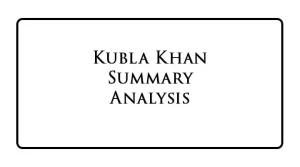Kubla Khan Summary and Analysis
Kubla Khan Poem
Or, a vision in a dream. A Fragment.
About Samuel Taylor Coleridge.
Samuel Taylor Coleridge was born on October 21, 1772, in the remote Devon village, England. His childhood is marked by isolation and self-absorption. In addition feelings of anomie, unworthiness, and incapacity persisted throughout a life of often compulsive dependency on others.
Coleridge grew up surrounded by books at school, at home, and in his aunt’s shop. The dreamy child’s imagination was nourished by his father’s tales of the planets and stars and enlarged by constant reading.He became a prominent poet in the Romantic era. A friend to poet William Wordsworth, Coleridge was a founder of the English Romantic Movement. His best-known poems are “The Rime of the Ancient Mariner” and “Kubla Khan,”
Analysis of the poem Kubla Khan
The poem describes about the palace built by Kubla khan’s grandson of Chengis Khan, the great ruler of central Asia. This poem is subtitled as ” A vision in Dream: A fragment”. This poem shows the beauty of a dream. The poet takes opium and falls into drowsiness while reading a passage about the court of Kubla Khan from Samuel Purchas’s “pilgrimage” after taking some opium. In this dream like state, he composed a few hundred lines of poetry and when he wakes up, he immediately wrote it down. Unfortunately a visitor interrupted him and when the poet had a chance to return to his writing, the images had fled leaving him with only vague recollections and the remaining 54 lines of this fragmentary poem. The person who disturbed Coleridge has become a metaphor for the malicious interruptions the world throws in the way of inspiration and genius.
Kubla Khan poem is an example of pure poetry removed from any intellectual content. Romantics focused on emotions and not on intellectual and logical thoughts. Since it is a dream we cannot make clear meaning and cannot expect coherence and cohesion between the lines. Thus some critics argue that there are no themes in this poem as it cannot be understood as a whole rather each stanza talks about totally different ideas from the rest of the poem.
Coleridge developed his ideas on the relationship between poetry and dreams throughout much of his lifetime. He was fascinated by the fact that a dreamer passes no judgement and accepts with full faith all that is happening within the dream. The aim of a poet is to create a state of illusion for the reader that is akin to dreaming (O’Connell). She further says that “for a waking mind dreams often seems absurd and irrational”. This is exactly happening in this poem as well. Once readers finish reading this poem, they are in the state of illusion and left with confusion. Moreover some readers find it absurd as there is no connection between the lines and each stanza appears as a fragment.
Since this is a dream poem, it has many dream elements. Most striking dream element is symbolic language. He evokes familiar images like dome, river, caverns, sea, gardens, forests, fountain, etc and allows symbolic interpretation where there is a possibility for different interpretation. For example Kubla Khan in itself is an image which evokes exoticism and mystery. Moreover he stands for “power and authority”. “The fountain that bursts forth from beneath the earth readily suggests, in the context of the poem, the act of creating when the conscious poet changes ideas in the mind into words on the page, and inspiration when unconscious ideas become conscious, but can also suggest sexual intercourse or laboured birth” (Wheeler, 1981)
Coleridge has achieved what he calls the aim of a true poet by creating a state of poetic illusion akin to dreaming. He places his reader in a ‘charmed sleep,’ creating for him a waking-dream experience and it is through this artful balance and waking judgement that ‘Kubla Khan’ has its success as a dream poem.
Kubla Khan Themes
- Poetic creativity
- Power of human mind and imagination
Kubla Khan Literary techniques
- Simile:
- “huge fragments vaulted like rebounding hail.” The fragments have been compared to pieces of hailstorm to show their impacts.
- “Forests ancient as hills”
- Personification:
- “as if this earth in fast thick pant was breathing,” comparing the earth to a breathing human being.
- “the dancing rocks.” Dancing is a human characteristic, but the poet has attributed this quality to rocks.
- Metaphor: Here the
- “deep romantic chasm” represents the creativity and deep imagination of the poet.
- Assonance:
- “deep delight”
- “Through caverns measureless to man.”
- Alliteration:
- “sympathy and song.”
- Imagery –al throughout the poem
Kubla Khan Line by Line Explanation
The following video explain Kubla Khan Poem line by line.
Read Related Poems Summary: The Solitary Reaper Analysis By William Wordsworth
Read Related Poems Sumary: Ozymandias Summary & Analysis by Percy Bysshe Shelley
 e-Kalvi e-Kalvi is the e-learning portal for general education. This is specially designed according to syllabuses of the students from grade 1 to 13.
e-Kalvi e-Kalvi is the e-learning portal for general education. This is specially designed according to syllabuses of the students from grade 1 to 13.


